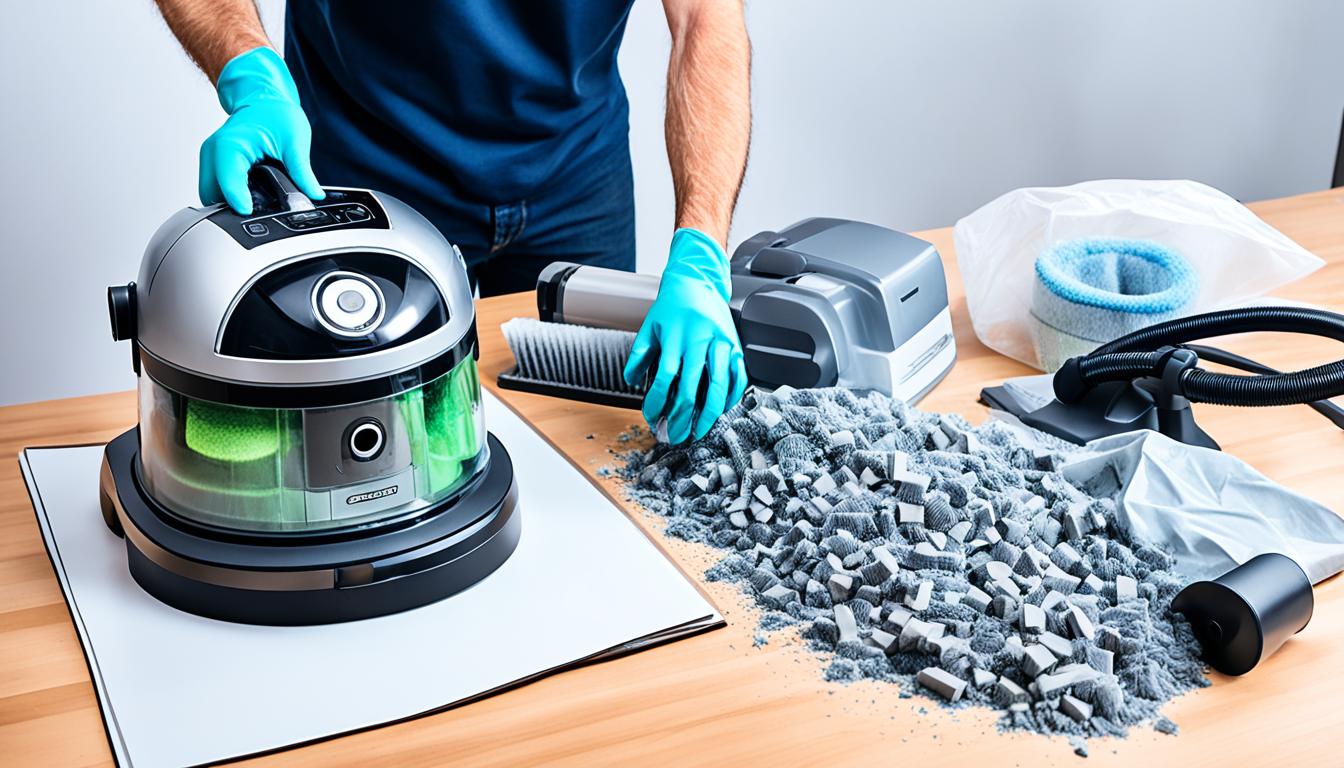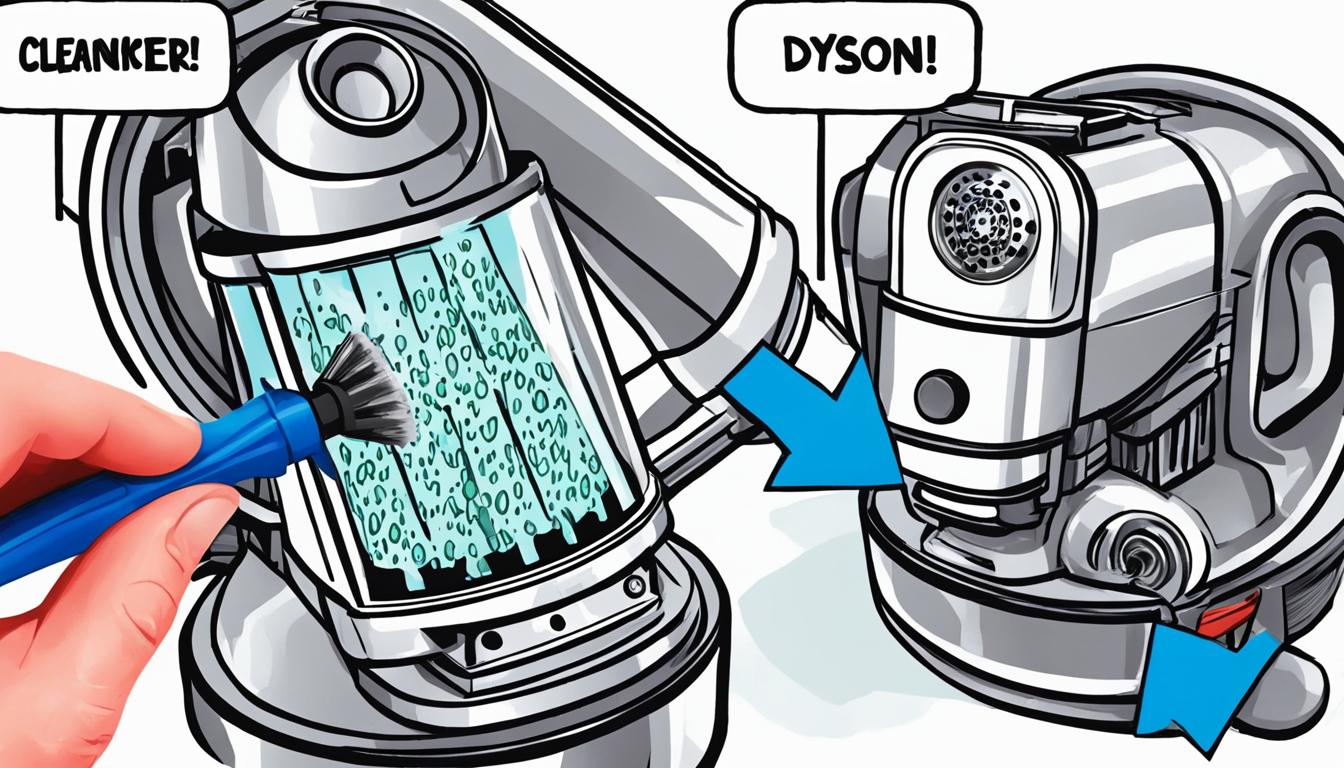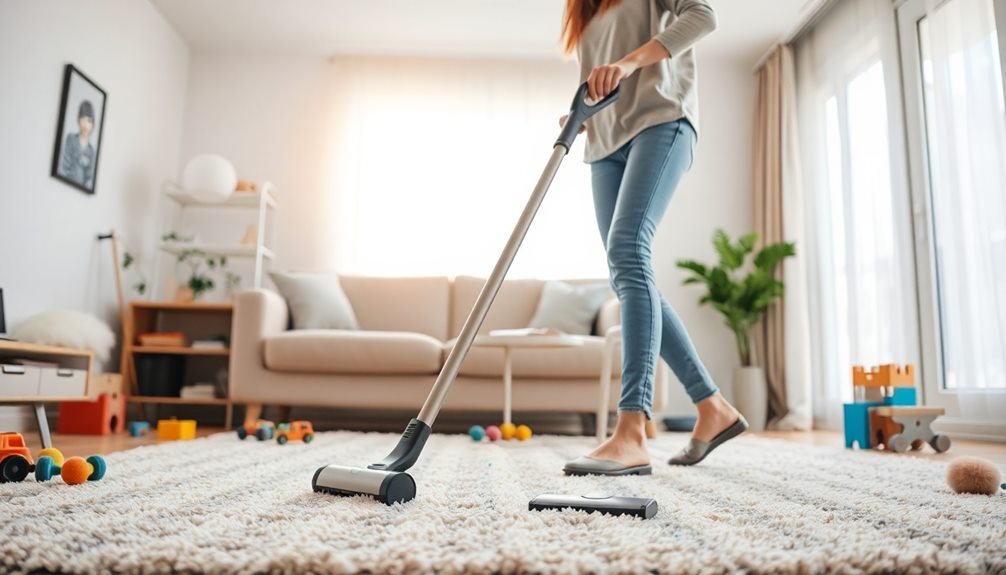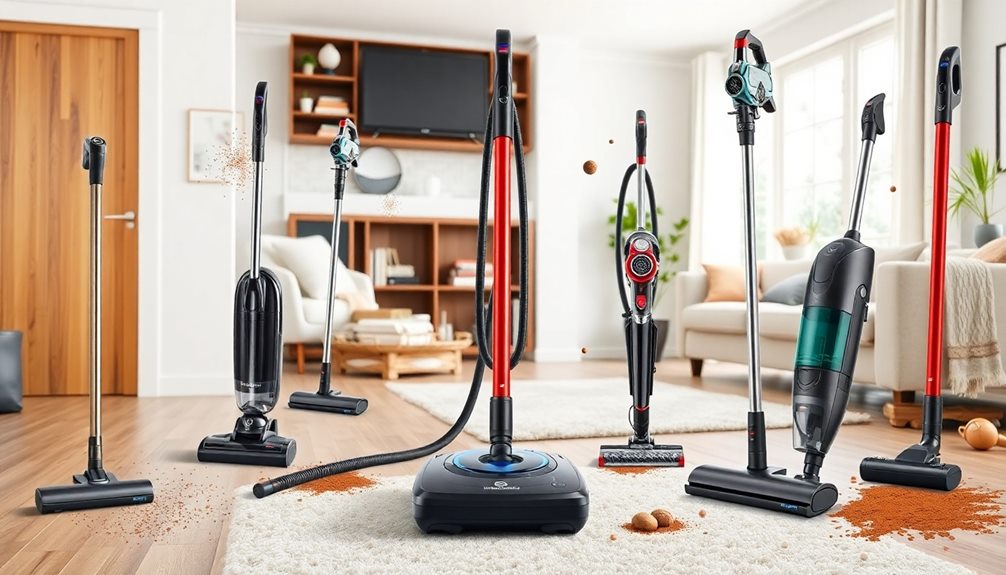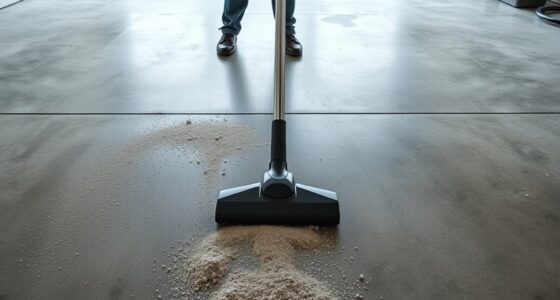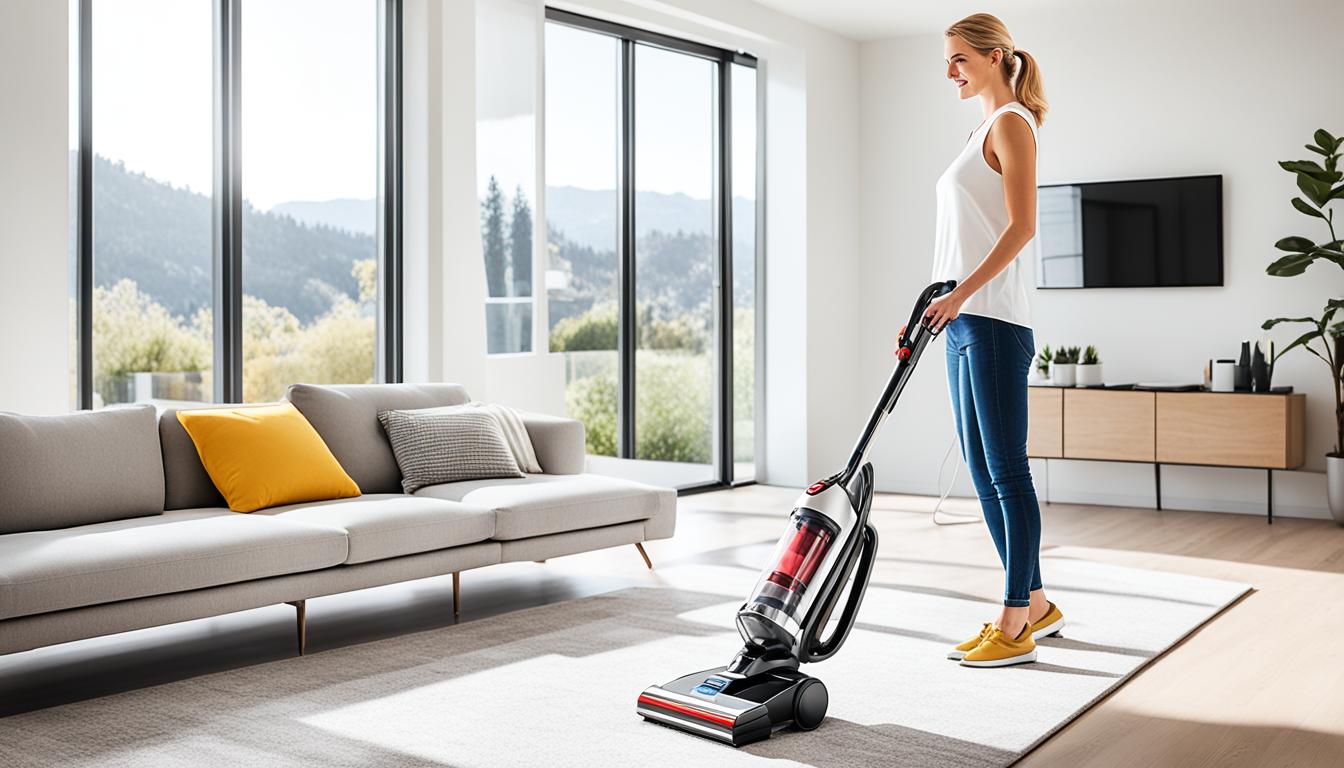Cleaning your vacuum cleaner is essential to ensure peak performance and longevity. We all know the frustration of a vacuum that just isn’t picking up as it should, leaving behind crumbs, pet hair, and dust. It’s time to take matters into your own hands and give your trusty cleaning companion the attention it deserves.
Picture this: You’re vacuuming away, and suddenly, the suction power decreases, or there’s an unpleasant smell coming from the machine. It’s not a pleasant experience, is it? But don’t worry, because in this easy guide, we will walk you through the process of cleaning your vacuum cleaner from top to bottom, so you can have it working like new again.
Whether you have a bagless vacuum cleaner, a vacuum with a bag, or even a cordless vacuum, we’ve got you covered. We will provide you with step-by-step instructions on how to clean different parts of your vacuum, including the filter, hose, brushes, and bag. We will also share tips for troubleshooting and deep cleaning your vacuum cleaner so you can tackle any issues that may arise.
Get ready to show your vacuum cleaner some love and keep your home spick and span with our comprehensive guide to vacuum cleaner maintenance.
Key Takeaways:
- Regularly cleaning your vacuum cleaner is essential for maintaining optimal performance and extending its lifespan1.
- Different types of vacuum cleaners require specific cleaning methods. Bagless vacuums need thorough cleaning every six months or when efficiency decreases, while bagged vacuums should be deep cleaned every six months or as needed. For cordless vacuums, follow the manufacturer’s instructions for filter replacement2.
- Empty the dust cup or bin of bagless vacuum cleaners when the debris level reaches the top, or after every use. Replace vacuum bags when captured debris reaches the indicated full line. Clean your vacuum cleaner quarterly or monthly, depending on the level of dirt in your home3.
- Basic maintenance of a vacuum cleaner typically takes 10 to 30 minutes, with additional time needed for drying if parts have been rinsed. Serious repairs may require a couple of hours1.
- Regularly tap and rinse filters, clear any clogs, and check for tangled hair around the brush roll to keep your vacuum running smoothly. For deeper maintenance issues, such as lack of suction power or frequent power cuts, consult the manufacturer or professional repair services if necessary1.
Tips for Cleaning a Vacuum
When it comes to maintaining the performance and longevity of your vacuum cleaner, proper cleaning and maintenance are essential. By following these vacuum cleaning tips, you can ensure that your vacuum continues to operate efficiently and effectively. Let’s explore some helpful tips for cleaning your vacuum.
1. Clean your vacuum filters regularly
Filters play a crucial role in trapping dust, allergens, and other particles, which is why vacuum cleaner maintenance often involves cleaning or replacing filters. According to statistical data4, some high traffic areas may require vacuum filters to be cleaned monthly, while for most households, a cleaning schedule of at least every three months is recommended4.
For instance, HEPA filters are highly efficient and capable of trapping 99.97% of particulates larger than 0.3 microns, including fine dust and allergens. They can be rinsed with water to flush out dust and improve their lifespan by removing accumulated particles. However, it’s important to note that manufacturers consider most pleated filters disposable and provide a replacement schedule. Paper filters should never be soaked or rinsed with water, as it can cause damage. Synthetic fiber filters, on the other hand, can be rinsed with water a few times to remove dust and air-dried for at least 24 hours4.
2. Check and clean the base plate and brushes
The base plate and brushes of your vacuum cleaner are prone to accumulating debris, especially after each use. Cleaning these parts regularly helps prevent clogs and maintains suction power. According to statistical data5, it is recommended to check and clean the base plate and brushes of your vacuum cleaner after every use. This ensures optimal performance and extends the lifespan of your machine5.
3. Empty dust containers and replace bags
Emptying the dust container of bagless vacuum cleaners after each use or when half full is crucial to prevent loss of suction power. Similarly, for vacuum cleaners with dust bags, replacing them when full or as per the manufacturer’s guidelines is essential for efficient operation. Regularly cleaning the dust containers and replacing bags as needed helps maintain optimal performance5.
4. Clean vacuum hoses and attachments
Vacuum hoses and attachments often come into contact with various surfaces, including upholstery and hard-to-reach areas. Cleaning them regularly, especially after each use, helps prevent blockages and ensures efficient functioning. According to statistical data5, it is recommended to perform regular cleaning of vacuum cleaner hoses and attachments, further ensuring the longevity and effectiveness of your machine5.
By following these vacuum cleaning tips, you can keep your vacuum cleaner in top shape, maximizing its performance and prolonging its lifespan. Remember to consult the owner’s manual of your specific vacuum model for manufacturer’s recommendations and instructions. With regular maintenance and cleaning, your vacuum cleaner will continue to provide reliable and effective cleaning performance.
How to Clean a Vacuum Without a Bag
Bagless vacuum cleaners offer convenience and cost savings, but proper cleaning is essential to maintain their effectiveness. Follow these steps to keep your bagless vacuum in peak condition:
- Start by removing the dust bin from the vacuum and emptying its contents into the trash. This should be done after every use to prevent loss of suction power and maintain optimal performance6.
- If the canister is washable, clean it with warm, soapy water. Gently scrub the inside with a microfiber cloth to remove any dirt or debris. Rinse thoroughly and allow it to dry completely before reassembly. If the canister is not washable, wipe it out with a microfiber cloth to remove dust and dirt7.
- Use compressed air cans to clean tight and dusty areas of the vacuum, such as crevices or corners. This will help remove any trapped dirt or debris that cannot be reached with a cloth. Be sure to follow the manufacturer’s instructions for safe and proper use of compressed air cans7.
- Next, clean the attachments that come with your vacuum. These may include brushes, nozzles, or extension wands. Use warm, soapy water to thoroughly clean these attachments. A microfiber cloth can also be used to wipe away any dust or debris. Rinse them well and allow them to dry completely before reattachment7.
- Inspect the HEPA filter and replace it every six months or as recommended by the manufacturer. The HEPA filter plays a critical role in maintaining optimal dust separation from the air in your vacuum. Regular replacement ensures efficient filtration and helps prevent dust and allergens from being released back into your home7.
- Remove the brush roller from the vacuum using a screwdriver, if it’s detachable. Check for tangled hair or debris wrapped around the roller. Use scissors to cut and remove any tangled hair. Tap or shake the brush roller to dislodge any lint or dust that may have accumulated. Cleaning the brush roller regularly helps maintain efficient performance7.
- While inspecting the brush roller, also check the belt and lubricate the brush bearings if necessary. A well-maintained belt and smooth brush bearings contribute to the overall effectiveness of your vacuum cleaner. Follow the manufacturer’s instructions for proper lubrication techniques7.
By following these cleaning steps, you can ensure that your bagless vacuum cleaner performs optimally and lasts longer. Regular maintenance and proper cleaning are key to keeping your vacuum in top condition.
How to Clean a Vacuum With a Bag
Cleaning a vacuum cleaner with a bag is essential for maintaining its performance and prolonging its lifespan. Here are some tips to help you properly clean your vacuum:
1. Check the Bag
Regularly check the bag in your vacuum to ensure it is not full. Bagged vacuum cleaners typically have an indicator light that signals a full bag. If there is no indicator light, it is advised to replace the bag when it is half-full2. Remember not to reuse paper bags or Wonderbags, as their pores get blocked when full, reducing suction efficiency8.
2. Remove and Replace the Bag
When the bag is full or needs to be replaced, follow the manufacturer’s instructions to remove it properly. Dispose of the bag and insert a new one according to the vacuum cleaner’s specifications.
3. Clean the Brush Roller
The brush roller in your vacuum cleaner can become wrapped with hair and debris over time, affecting its performance. Remove the brush roller and cut off any tangled hair or debris. Shake the brush roller outside to dislodge any remaining dust or dirt.
4. Check and Lubricate the Belt
Inspect the belt that drives the brush roller and ensure it is in good condition. If recommended by the manufacturer, lubricate the brush bearings to keep them functioning smoothly. Refer to the owner’s manual for specific instructions.
5. Clean or Replace Filters
Filters play a crucial role in maintaining the suction power and overall effectiveness of your vacuum cleaner. Follow the manufacturer’s instructions to clean or replace the filters regularly. For vacuum cleaners with microfilters, it is recommended to change the microfilters after every 6 bag changes8. HEPA filter cassettes should be replaced every 6 months8, while the entire filter system should be replaced annually8.
6. Maintain the Motor Filter
In some cases, vacuum cleaners may stop running due to the overheating protection breaker activating. This requires cleaning the motor filter and replacing the dust bag8. Regularly check the motor filter and clean it as needed to ensure proper ventilation and prevent motor failure.
7. Troubleshoot Poor Suction or Unusual Noises
If you notice poor suction or unusual noises coming from your vacuum, it could be due to various causes. Check for blocked airflow, ensure the bag or container is not full, and inspect the filters for cleanliness and proper installation8. Addressing these issues can often restore your vacuum’s performance.
Remember to always refer to the manufacturer’s instructions and guidelines when cleaning your vacuum cleaner with a bag. Proper maintenance and cleaning will not only improve its performance but also contribute to a cleaner and healthier living environment.
| Statistical Data | Source |
|---|---|
| Reuse of paper bags or Wonderbags in vacuum cleaners should be avoided as the pores get blocked when full | 8 |
| Textile bags in vacuum cleaners can be washed and reused after being dried for at least 24 hours | 8 |
| Change microfilters after every 6 bag changes in vacuum cleaners with microfilters | 8 |
| HEPA filter cassettes in vacuum cleaners should be replaced every 6 months | 8 |
| Vacuum cleaner dust bags should be changed when suction power decreases, unusual noise occurs, or it starts to whistle | 8 |
| The filter system in vacuum cleaners should be replaced annually | 8 |
| Vacuum cleaners may stop running due to the overheating protection breaker activating, requiring the motor filter to be cleaned and the dust bag replaced | 8 |
| Poor suction or unusual noises in the vacuum may be due to various causes, such as blocked airflow or a full bag or container | 8 |
| Proper maintenance and cleaning of vacuum cleaners are important to avoid dangers associated with damaged power cords | 8 |
| Electro-suction brushes in vacuums are motorized rotary brushes for efficient cleaning | 8 |
| Disposal of vacuums at the end of their lifespan can be done at local civic waste collection points for recycling | 8 |
| Consumers missing parts in newly opened appliances should contact the Consumer Services Center for a suitable solution | 8 |
| Accessories, consumables, and spare parts for appliances can be found in the “Accessories” section of the website | 8 |
| Warranty conditions for appliances can be located in the Warranty section of the website | 8 |
How to Clean a Cordless Vacuum
Cordless vacuums are convenient and efficient for cleaning various surfaces. To ensure their optimal performance and longevity, regular maintenance and cleaning are essential. Follow these steps to clean your cordless vacuum:
- Disconnect the vacuum from the charger and turn it off. This is important for safety and to avoid damage to the vacuum and yourself9.
- Remove the dust bin or canister from the vacuum. Most cordless vacuums have a release button or latch to easily detach the dust bin. Empty the contents into a trash bag. It is recommended to empty the dust bin after each use or when full9.
- Inspect the dust bin for any remaining debris or dirt. Use a small brush or compressed air to clean the interior of the bin thoroughly. Pay attention to the corners and crevices where dirt can accumulate10.
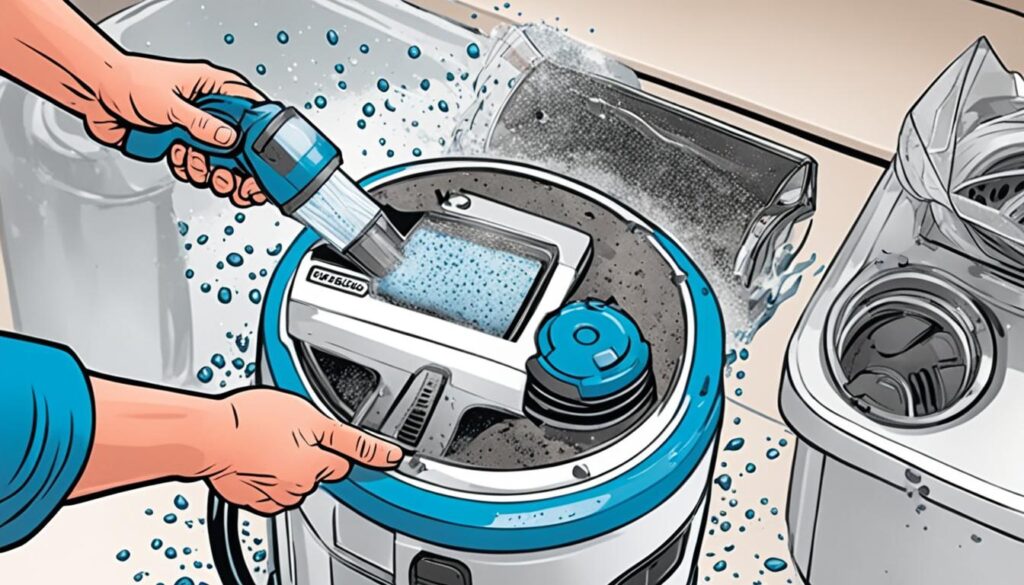
- Remove the roller brush or floor tool from the vacuum. Depending on the model, you may need to use a screwdriver or follow the manufacturer’s instructions to unlock and remove the roller brush. Check the brush for any tangled hair, threads, or debris. Use scissors or your fingers to carefully remove any obstructions. Clean the area that houses the roller brush as well11.
- Inspect the vacuum filter. If it is washable, rinse it under running water according to the manufacturer’s instructions. Allow the filter to dry completely before reinserting it into the vacuum. If the filter is disposable, replace it with a new one as recommended. Proper filter maintenance ensures optimal suction and performance911.
- Wipe down the exterior of the vacuum with a damp cloth. Pay attention to the charging port, buttons, and any other areas that may require cleaning. Make sure the vacuum is turned off and unplugged before cleaning the battery or the charging port9.
- Once all the parts are dry, reassemble the vacuum. Make sure the dust bin, roller brush, and filter are securely in place. Refer to the manufacturer’s instructions for proper reassembly9.
Following these cleaning steps regularly will help maintain the performance and efficiency of your cordless vacuum cleaner. By keeping your vacuum clean, you can ensure effective suction, extend its lifespan, and enjoy hassle-free cleaning. Remember to always refer to the manufacturer’s instructions for specific cleaning recommendations and guidelines.
How to Clean a Vacuum Hose
Cleaning the vacuum hose is an essential part of vacuum cleaner maintenance. A clogged hose can lead to a loss of suction and difficulty picking up dirt. It may also cause the vacuum to blow out dust, produce strange noises, or emit a bad smell12.
To effectively unclog a vacuum hose, start by removing it from the vacuum. Then, insert a dryer vent brush or the handle of a broom into the hose to dislodge any debris13. Be careful not to damage the hose while doing this. Afterward, wipe off the outside of the hose with a microfiber cloth to remove any dirt or dust12.
Visually inspecting the inside of the hose after a deep clean is also recommended to check for any remaining clogs12. If clogs persist, you can try using needle-nose pliers to remove them13.
Sanitizing the vacuum hose regularly is important for cleanliness. Two common household items that can be used for this purpose are baking soda and distilled white vinegar12. Mix them with water in a ratio of 1:1 and run the solution through the hose. This helps eliminate odors and removes any built-up grime or bacteria13.
If you need to replace a vacuum hose, various sizes are available, such as 32mm, 35mm, 38mm, 51mm, and 76mm. Some hoses also come with anti-static options, which can help prevent dust buildup12. For inquiries about vacuum hose replacements, you can contact the Auckland Office at +64 9 520 20 30 or the Wellington Office at +64 4 234 102012.
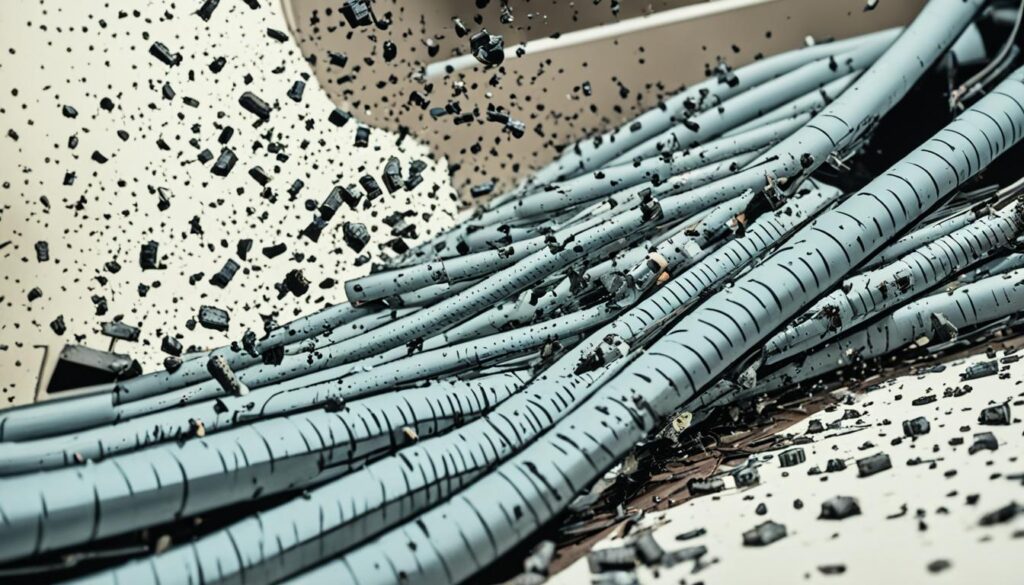
Tips for Cleaning a Vacuum Hose:
- Remove the hose from the vacuum before cleaning
- Use a dryer vent brush or broom handle to dislodge debris
- Wipe the outside of the hose with a microfiber cloth
- Inspect the inside of the hose for any remaining clogs
- Try using needle-nose pliers to remove stubborn clogs
- Sanitize the hose with a mixture of baking soda and vinegar
- Consider replacing the hose if necessary
Keeping your vacuum hose clean and free from clogs is crucial for maintaining optimal performance and ensuring clean floors. Regular maintenance and proper cleaning techniques will extend the life of your vacuum cleaner and help it maintain its suction power12.
How to Clean a Vacuum Cleaner That Smells
If your vacuum cleaner smells, it’s time to give it a thorough cleaning. A smelly vacuum not only affects the cleanliness of your home but can also indicate potential issues with the machine. Follow these steps to freshen up your vacuum and get rid of unpleasant odors.
1. Empty the vacuum cleaner and discard the contents in the outside trash. Dust, debris, and pet hair can accumulate inside the vacuum, leading to foul odors. Removing the debris is the first step in eliminating the source of the smell14.

“Emptying the vacuum bag or collection container regularly is crucial in preventing odors caused by trapped dirt and debris.”14
2. Clean the vacuum to remove any lingering odors and bacteria. Use an anti-bacterial wipe to clean the exterior surfaces of the vacuum, including the handle and attachments. Let the vacuum dry thoroughly before using it again15.
3. If your vacuum has a washable canister, remove it and wash it with warm, soapy water. Rinse it thoroughly and let it dry completely before reassembling the vacuum. This step helps eliminate dirt and bacteria that may be contributing to the smell15.
“Cleaning the vacuum components, such as the canister or dust collection bag, helps remove odor-causing bacteria and mold.”14
4. Check and replace any worn or damaged belts and cords. Over time, vacuum belts can wear out and cause burning smells. By replacing them regularly, you can prevent unpleasant odors and keep your vacuum operating at its best15.
5. For bagged vacuums, using a new bag can help freshen up the appliance. Place a dryer sheet or sprinkle a few drops of vanilla extract on a paper towel, and then place it in the bag. As you vacuum, the bag will release a pleasant scent, masking any existing odors14.
“Using scented dryer sheets or essential oils in the vacuum bag can add a pleasant fragrance to the cleaner.”14
6. Robot, smart home enabled, or backpack vacuums may require specific cleaning instructions provided by the manufacturer. Follow the manufacturer’s guidelines to ensure effective cleaning and maintenance of these specialized vacuum models14.
By following these cleaning steps, you can eliminate odors and ensure that your vacuum cleaner is fresh and ready to tackle your cleaning tasks. Regular maintenance and cleaning help prolong the life of your vacuum and maintain its performance16.
Tips for Cleaning a Smelly Vacuum Cleaner
| Steps | Benefits |
|---|---|
| Empty the vacuum cleaner | – Removes trapped debris causing odors – Improves suction power14 |
| Clean the vacuum | – Eliminates bacteria and mold14 – Refreshes the appliance15 |
| Wash washable canisters | – Removes dirt and smells15 |
| Check and replace belts and cords | – Prevents burning smells – Ensures optimal performance15 |
| Use a new bag with a freshener | – Adds a pleasant scent during vacuuming14 |
Frequency of Cleaning Vacuum Parts
Proper maintenance is key to prolonging the lifespan and ensuring optimal performance of your vacuum cleaner. To keep your vacuum running smoothly, it’s important to clean various parts regularly. Here are the recommended frequencies for cleaning different components:
Brushes and Bristles
The brushes and bristles of your vacuum cleaner should be cleaned after every use to remove debris and hair. Regular cleaning prevents clogs and maintains the effectiveness of the brushing action. Remember to consult the manufacturer’s instructions for specific cleaning techniques for your vacuum model.
Vacuum Canister
It’s essential to empty the vacuum canister regularly to prevent it from becoming too full and hindering suction. The recommended frequency for emptying the canister is after every few uses or when it reaches half to two-thirds full. This ensures optimal performance and prevents the overflow of debris into other parts of the vacuum17.
Filters
Cleaning the filters is crucial for maintaining the efficiency of your vacuum cleaner. The specific cleaning frequency for filters depends on their type and usage. For most filters, it’s recommended to clean them about once a month. However, if you have pets or if you vacuum frequently in a dusty environment, it’s advisable to clean the filters twice a month to prevent clogs and maintain effective suction. Deep cleaning or replacing the filters every 12 to 18 months is also recommended to ensure optimal performance18.
Hoses
The hoses of your vacuum play a vital role in suction power. If you notice a reduction in suction, it’s recommended to clean the hoses to remove any obstructions. Cleaning the hoses as needed will help maintain optimal performance and prevent clogs. Consult the manufacturer’s instructions for guidance on cleaning and maintaining the hoses of your specific vacuum model.
Exterior
Regularly cleaning the exterior of your vacuum cleaner is important to prevent dust and dirt build-up. It’s recommended to wipe down the exterior surfaces weekly to maintain the cleanliness of your vacuum and prolong its lifespan.
“Regular maintenance of your vacuum cleaner is essential to keep it running smoothly and efficiently. By following the recommended cleaning frequencies for different parts, you can ensure optimal performance and prevent issues like clogs and reduced suction power.” – Vacuum Expert
By following these cleaning frequencies for different vacuum parts, you can maintain the performance and efficiency of your vacuum cleaner. Cleaning regularly not only ensures optimal suction power but also helps prevent odors and keeps your home clean and fresh. Taking care of your vacuum cleaner will extend its lifespan and save you money in the long run. So don’t forget to clean your vacuum regularly and enjoy cleaner and healthier living spaces.
How to Deep Clean Your Vacuum
Deep cleaning your vacuum once a year is crucial for thorough maintenance. It helps ensure optimal performance and extends the lifespan of your vacuum cleaner. Follow these steps to deep clean your vacuum and keep it in top condition throughout its lifetime.
Step 1: Gather Your Cleaning Supplies
- Disinfectant spray
- Hot water
- Dish soap
- Cleaning brush
- Bleach
- Vinegar
- Baking soda
- Compressed air
- Cleaning cloth
Step 2: Disassemble the Vacuum
Begin by unplugging your vacuum cleaner and removing any attachments or accessories. Check the manufacturer’s instructions for guidance on disassembling your specific model. This will allow you to access all the necessary parts for deep cleaning.
Step 3: Scrub the Washable Parts
Take the washable parts, such as the dust canister, filters, hoses, and brush heads, and scrub them in warm, soapy water. Use a cleaning brush to remove any debris or dirt buildup. Thoroughly rinse the parts with hot water and allow them to air dry completely before reassembly. Properly cleaning and drying these parts helps prevent the growth of mold and bacteria19.
Step 4: Remove Dust and Debris
Use a can of compressed air to blow out any dust and debris from hard-to-reach areas of your vacuum cleaner. Pay special attention to the nooks, crevices, and vents. This will help maintain optimal suction and prevent clogs19.
Step 5: Disinfect the External Parts
Spray the external parts of your vacuum cleaner with a disinfectant spray and wipe them clean using a cleaning cloth. This helps kill any remaining germs and keeps your vacuum hygienic19.
Step 6: Reassemble the Vacuum
Once all the parts are thoroughly dry, reassemble your vacuum cleaner according to the manufacturer’s instructions. Make sure everything is properly aligned and secured for optimal performance.
By deep cleaning your vacuum on a regular basis, you can ensure that it continues to function efficiently and effectively. Regular maintenance not only helps remove dirt and debris but also prevents the buildup of mold, bacteria, and odors. It can extend the lifespan of your vacuum cleaner and contribute to a cleaner and healthier home environment1920.
Remember to perform regular cleaning of your vacuum parts, including filters, brushes, and bristles, after each use or according to manufacturer recommendations. This helps prevent the accumulation of odors and maintains optimal performance until the next deep clean19206.
Consider using natural cleaners like essential oils, such as thyme and lemongrass. Spraying a mixture of these oils inside your vacuum can help fight mold and keep it smelling fresh19.
It’s important to note that different vacuum cleaners may have specific cleaning requirements. Always refer to the manufacturer’s instructions for detailed guidance on cleaning and maintenance. Taking the time to deep clean your vacuum regularly will ensure that it continues to perform at its best and keeps your home clean and healthy for years to come.
Preventing and Deodorizing Vacuum Odors
To keep your vacuum smelling fresh and clean, it’s important to take preventive measures and use effective deodorizing techniques. Here are some tips to help you maintain a pleasant-smelling vacuum:
Solution 1: Baking Soda
One simple and inexpensive way to eliminate odors from your vacuum cleaner is by using baking soda. Sprinkle a generous amount of baking soda into the dust bin or bag to absorb unpleasant smells. Vacuum as usual to remove the baking soda and freshen the air. Baking soda is a natural deodorizer and can effectively neutralize odors in the vacuum cleaner.
References:21
Solution 2: Essential Oils
Add a few drops of your favorite essential oil, such as thyme or lemongrass, to a spray bottle filled with water. Spray the mixture inside the vacuum container, bag, or filter to spread a pleasant fragrance while you clean. However, it is important to verify compatibility with your specific vacuum model and conduct patch tests on flooring to avoid any potential damage.
References:22
Solution 3: Cinnamon
Cinnamon, particularly in powdered form, can be used to freshen your vacuum cleaner. Sprinkle some cinnamon powder on the floor before you start vacuuming. As you clean, the warm scent of cinnamon will be released, making the cleaning experience more enjoyable. The aroma of cinnamon can also help mask any unpleasant odors in the vacuum.
References:21
Regular Cleaning
Regularly cleaning your vacuum parts is essential in preventing and eliminating odors. Clean the dust bag or container and empty it regularly to prevent odors from accumulating. Additionally, clean or replace the filters as recommended by the manufacturer to maintain a fresh-smelling vacuum. Don’t forget to check and clean the brushes, as dirt and debris can build up over time and contribute to odor buildup. Lastly, washing the hoses with water helps eliminate biofilm and dirt that can cause unpleasant smells.
References:21
Frequency of Cleaning
Consider cleaning the vacuum brush at least two times annually or more frequently if you use it frequently. When it comes to filter replacement, it’s recommended to follow the manufacturer’s recommendations or replace them earlier, especially if you pick up odor-causing debris. Soaking the vacuum hoses for a couple of hours is another effective method to remove odor-causing buildup.
References:21
By implementing these preventative measures and deodorizing techniques, you can ensure that your vacuum cleaner remains fresh and odor-free. Regular maintenance and cleaning of your vacuum, as well as using natural deodorizers like baking soda and essential oils, will help you enjoy a clean and pleasant-smelling home.
When to Replace Your Vacuum Cleaner
On average, vacuum cleaners have a median lifespan of eight years, according to Consumer Reports23. However, the actual lifespan can vary depending on the brand and frequency of use23. With proper maintenance and care, you can extend the lifespan of your vacuum cleaner to up to ten years24.
There are several signs that indicate it may be time to replace your vacuum cleaner. If your vacuum is emitting more pollutants or allergens, it could be a sign that the filters are no longer effective and need replacement23. Similarly, if your vacuum is not performing as well as it used to and lacks suction power, it might be time for an upgrade23.
Technology has advanced, and newer vacuum cleaner models offer improved features and performance compared to older models23. Consider upgrading to a cordless vacuum or a robot vacuum for added convenience and efficiency in your cleaning routine23. Cordless vacuums offer the flexibility to clean without the constraints of a power cord, while robot vacuums can autonomously clean your home, saving you time and effort23.
When shopping for a new vacuum cleaner, it’s essential to consider your needs and budget. Vacuum cleaner prices can range from around $150 to $1,500, depending on the brand and features25. Budget-friendly options like the Anker Eufy robot vacuum are priced at $96, while the Moosoo XL-618 cordless stick vacuum cleaner is another affordable choice priced at around $15025. High-end robot vacuums can cost between $350 and $1,500, and quality cordless vacuum models range from $300 to $75025.

Ultimately, the decision to replace your vacuum cleaner depends on its performance, maintenance needs, and budget. Regular maintenance, such as cleaning or replacing the filter and checking drive belts for any issues, can help prolong the lifespan of your vacuum cleaner2324. However, if your vacuum is consistently underperforming or experiencing frequent breakdowns even with proper maintenance, it may be more cost-effective to invest in a new one24.
Upgrading to a new vacuum cleaner with advanced features and improved performance can make your cleaning tasks easier and more efficient23. Whether you opt for a cordless or robot vacuum, selecting a model that suits your needs will ensure a cleaner and healthier home environment23. So, when the time comes, do your research and choose a vacuum cleaner that will help you maintain a clean and hygienic living space.
Conclusion
Regular cleaning and maintenance are crucial for the long-term performance and lifespan of your vacuum cleaner. By following these vacuum cleaning tips and guidelines, you can ensure that your vacuum remains in optimal condition. Cleaning the brushes, regularly emptying the canister, and cleaning or replacing filters are essential steps to maintain optimal suction power and prevent clogs. Additionally, deep cleaning your vacuum on a regular basis helps eliminate dirt and debris buildup that can impact its performance and longevity.
Remember, vacuum cleaner maintenance is not just about the vacuum itself. It’s also important to create a clean environment by keeping your home dust-free and regularly performing spring cleaning tasks. Hiring professional cleaners, such as Cosmopolitan Maid Service, for specialized cleaning needs like spring cleaning or holiday house cleaning can reduce stress and ensure a thorough cleaning of hard-to-reach areas. Plus, a clean kitchen is vital in creating a welcoming home and sharing memorable moments with loved ones.
When it comes to improving air quality, consider the benefits of using vacuums equipped with HEPA filters. These powerful filters can trap up to 99.97% of tiny particles, including dander, dust, and common allergens, significantly improving indoor air quality26. Regular cleaning of the HEPA filter is important, especially for daily vacuum use, to maintain its effectiveness26.
Lastly, research highlights the importance of increasing vacuum cleaner longevity through design interventions and improved ease of maintenance. Extending the lifetime of vacuum cleaners not only benefits the environment but also offers economic advantages27. Manufacturers are focused on innovations that make vacuum cleaners more user-friendly and time-saving, with prices dropping considerably in real terms27. By implementing these vacuum cleaning tips and maintaining your vacuum regularly, you can enjoy clean and fresh surroundings while extending the lifespan of your vacuum cleaner.
